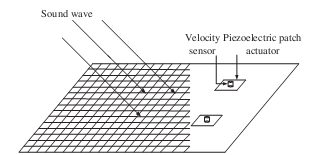Multi-channel feedback control is one major control strategy inactive structural acoustic control, when the disturbance is broadband in nature and appears mainly at relatively low frequencies. There are two kinds of multi-channel feedback controls, namely, the centralized control and the decentralized control.
Wherein, decentralized feedback control is a less complicated control strategy. Recently, the decentralized velocity feedback control received extensive attention due to its less complexity, good stability and it gives nearly the same performance as the centralized control. Besides, the decentralized velocity feedback control is a relatively robust control method.
Feedback gain is a key factor in decentralized velocity feedback control. It is known that an optimal feedback gain value exists with which the active damping effect could be maximized. In this research, a method of finding suitable feedback gains for decentralized velocity feedback control with piezoelectric patch actuators is investigated numerically. The diagram of decentralized velocity feedback control of a plate using piezoelectric patch actuator is shown in Fig. 1, in which a thin panel is subject to an incident plane acoustic wave.

Fig. 1. Decentralized feedback control of plate with piezoelectric patch actuators (Image by CAO).
The research calculates energy absorption of piezoelectric patch actuators. As well, the concept of virtual energy absorption of the piezoelectric patch actuator is proposed, through which the optimal feedback gain can be got conveniently. Numerical investigations are performed to explore the relationships between the virtual energy absorption by piezoelectric patch actuators and the kinetic energy of the structure. The results show that maximizing the broadband virtual energy absorption is nearly equivalent to minimizing the kinetic energy. A robust self-tuning algorithm is also proposed with maximizing the broadband virtual energy absorption. This algorithm can simultaneously update feedback gains of more than one control units, and find the optimal feedback gains automatically.
This work is supported by National Natural Science Foundation of China (Grant Nos. 11004216, 11004217) and the Knowledge Innovation Program of Institute of Acoustics, Chinese Academy of Sciences.
The research entitled “Virtual Absorbed Energy in Decentralized Velocity Feedback Control of a Plate with Piezoelectric Patch Actuators” has been released online of http://www.sciencedirect.com/science/article/pii/S0003682X13000030# and published in the journal of Applied Acoustics (Volume 74, Issue 6, Pages 909–919, June 2013).
Contact:
CAO Yin
Key Laboratory of Noise and Vibration Research, Institute of Acoustics, Chinese Academy of Sciences, Beijing (100190), China
Email:caoyin@mail.ioa.ac.cn


